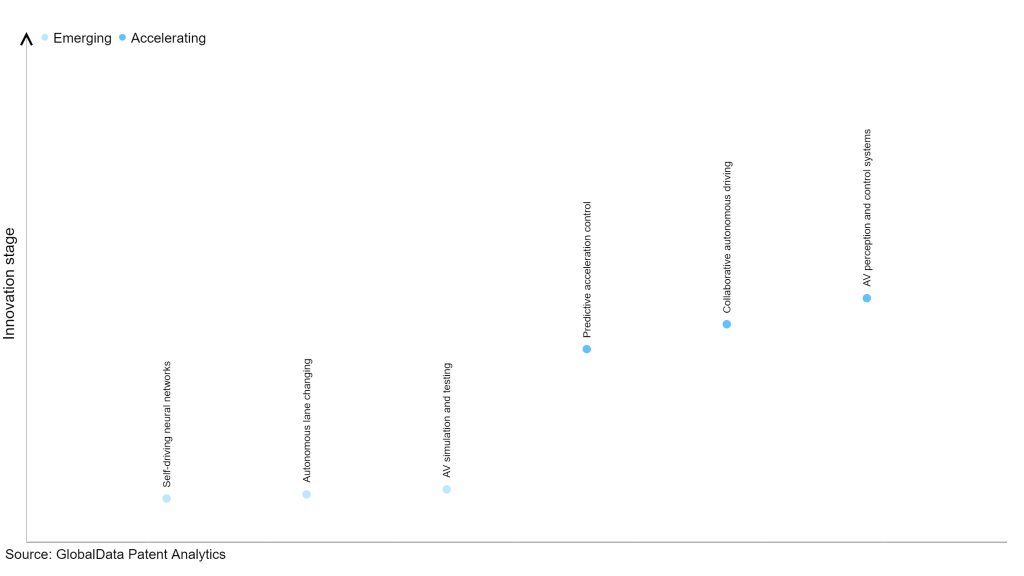The automotive industry continues to be a hotbed of patent innovation. Collaborative autonomous driving (CAD) is driving innovation in the automotive industry due to its potential to improve safety, efficiency, cost, and regulation. CAD allows autonomous vehicles (AVs) to communicate and coordinate, reducing collision risks, reducing traffic congestion, and reducing the need for expensive sensors and computing hardware. Governments worldwide are developing regulations to ensure safe and efficient operation of AVs. The automotive industry is utilizing technologies such as vehicle to vehicle (V2V) communication, vehicle to infrastructure (V2I) communication, cloud-based CAD systems, and edge computing to improve collaborative autonomous driving systems. These technologies, while still under development, have the potential to revolutionize CAD systems and accelerate the deployment of safe and reliable AVs. In the last three years alone, there have been over 720,000 patents filed and granted in the automotive industry, according to GlobalData’s report on Artificial intelligence in automotive: collaborative autonomous driving. Buy the report here.
However, not all innovations are equal and nor do they follow a constant upward trend. Instead, their evolution takes the form of an S-shaped curve that reflects their typical lifecycle from early emergence to accelerating adoption, before finally stabilizing and reaching maturity.
Identifying where a particular innovation is on this journey, especially those that are in the emerging and accelerating stages, is essential for understanding their current level of adoption and the likely future trajectory and impact they will have.
300+ innovations will shape the automotive industry
According to GlobalData’s Technology Foresights, which plots the S-curve for the automotive industry using innovation intensity models built on over one million patents, there are 300+ innovation areas that will shape the future of the industry.
Within the emerging innovation stage, self-driving neural networks, autonomous lane changing and AV simulation and testing are disruptive technologies that are in the early stages of application and should be tracked closely. Predictive acceleration control, collaborative autonomous driving, and AV perception and control systems are some of the accelerating innovation areas, where adoption has been steadily increasing.
Innovation S-curve for artificial intelligence in the automotive industry

Collaborative autonomous driving is a key innovation area in artificial intelligence
Collaborative autonomous driving refers to a system where multiple vehicles and devices interact and communicate with each other to improve driving safety and efficiency. This involves data sharing, analysis of driving behavior, seamless switching of road side units, information interaction between vehicles, driving risk analysis, and the construction of map data. By utilizing collaborative autonomous driving, vehicles can cooperate and make informed decisions, resulting in safer and more efficient driving.
GlobalData’s analysis also uncovers the companies at the forefront of each innovation area and assesses the potential reach and impact of their patenting activity across different applications and geographies. According to GlobalData, there are 1210+ companies, spanning technology vendors, established automotive companies, and up-and-coming start-ups engaged in the development and application of collaborative autonomous driving.
Key players in collaborative autonomous driving – a disruptive innovation in the automotive industry
‘Application diversity’ measures the number of applications identified for each patent. It broadly splits companies into either ‘niche’ or ‘diversified’ innovators.
‘Geographic reach’ refers to the number of countries each patent is registered in. It reflects the breadth of geographic application intended, ranging from ‘global’ to ‘local’.
Patent volumes related to collaborative autonomous driving
Source: GlobalData Patent Analytics
Ford Motor, the leading automotive patent holding company in collaborative autonomous driving, has filed a patent for a CAD system that enables real-time communication and coordination between autonomous vehicles. The system uses sensors such as cameras, radar, and LiDAR to collect data and process it by a cloud-based server. This could improve safety, efficiency, and fuel efficiency in complex traffic situations. Toyota Motor and Intel are some of the other leading patent filers in CAD innovation, contributing to the development of safe and reliable AVs.
In terms of application diversity, Cloudparc leads the pack. Didi Global and Kyocera stood in the second and third positions respectively. By means of geographic reach, INRIX held the top position followed by NIKE and Derq.
To further understand the key themes and technologies disrupting the automotive industry, access GlobalData’s latest thematic research report on Artificial Intelligence (AI) in Automotive.
Data Insights
From

The gold standard of business intelligence.
Blending expert knowledge with cutting-edge technology, GlobalData’s unrivalled proprietary data will enable you to decode what’s happening in your market. You can make better informed decisions and gain a future-proof advantage over your competitors.



